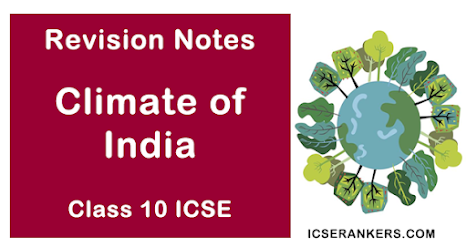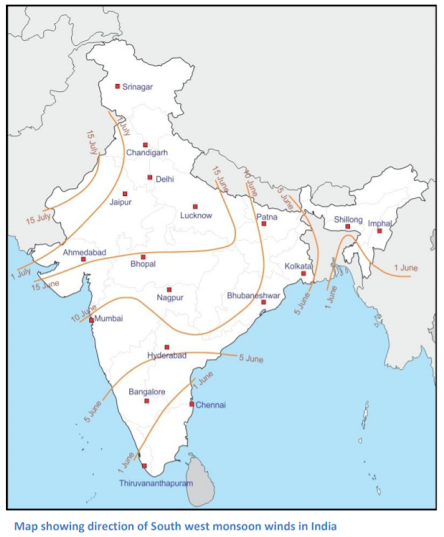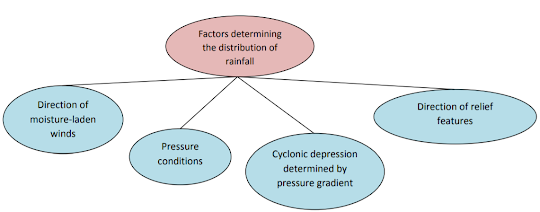ICSE Revision Notes for Climate of India Class 10 Geography
|
Chapter Name |
Climate of India |
|
Topics Covered |
|
|
Related Study |
Climate of India and Regional Variations
- India has a tropical monsoon type of climate. This is because India lies in the tropical belt and its climate is influenced by the monsoon winds. Hot summers and dry winters are characteristic of the monsoon type of climate.
- India has many relief features which affect its climate. For example, the Himalayas influence the climate of India in the following ways:
- It protects northern India from the cold winds which blow from central Asia. Without this range, the Indian plains would experience extremely cold climate.
- Northern India experiences continental type of climate because of the presence of the Himalayas. Main characteristics of this type of climate are hot summers, cold winters and little rainfall. The diurnal range (difference between maximum and minimum temperature) of temperature is also large.
Regional Variations
India has a vast latitudinal and longitudinal extent. Thus, it has vast regional variations. Some of these are:
- While Barmer in Rajasthan experiences a temperature of 48–50°C in June, Pahalgam in Kashmir experiences 22°C in the same month.
- While Kerala enjoys tropical climate with warm and moist air, Punjab experiences continental type of climate with severe heat during summers and severe cold during winters.
- While the temperature in Kerala remains at about 20–22°C during winters, in Kargil, the temperature may drop below −40°C.
- While the difference between day and night temperatures in Kerala is hardly 7–8°C, the diurnal range of temperature is extremely high in the Thar desert. The difference between the day and night temperature is between 25°C and 30°C.
- Precipitation also differs in the country. While the precipitation is in the form of snowfall over the Himalayas, it rains over other parts of the country.
- While Mawsynram and Cherrapunji receive about 1100 cm of rainfall in Meghalaya, Jaisalmer in Rajasthan receives only about 9 cm of rainfall annually.
- ∙ Most parts of India receive rainfall during June to September, but the coastal areas of Tamil Nadu receive rainfall during winters.
Factors Affecting the Climate of India
1. The Himalayas
- The Himalayas protect the North Indian Plains from severe cold winds which blow from Central Asia during winter.
- The rain-bearing winds blowing from the Arabian Sea bring in rainfall over the northern plains after striking the Himalayas. Central Asia lies in the rain shadow area of the Himalayas and hence hardly receives any precipitation from these winds.
2. The Monsoon Winds
- The monsoon winds affect the climate of India. The southwest monsoon winds blowing from the Arabian Sea and the Bay of Bengal bring rainfall over the entire country during June, July and August.
- By the beginning of October, the winds start to retreat from central India. The northeast monsoon winds bring rain to Tamil Nadu in winters.
3. Latitude
- The tropic of Cancer divides the country into two parts. The northern part lies in the temperate zone, while the southern part lies in the tropical zone.
- While the northern part of the country lying in the temperate zone experiences hot summer and cool winters, the southern parts of the country located in the tropical zone experiences hot climate.
4. Varied Relief
- Relief features play an important role in shaping the climate of India. The areas located in the windward side of the Western Ghats receive heavy rainfall, while the Deccan region lying on the leeward or rain shadow area of the Western Ghats receives very little rainfall.
- The southwest monsoon winds blow parallel to the Aravalli Range. The latter is not able to stop the moisture-laden winds, making Rajasthan a dry state.
- Areas located in southern Assam receive heavy rainfall compared to the regions located to their north. This is because the hills in Southern Assam block the winds and force them to shed their moisture. By the time these winds arrive in northern Assam, they are comparatively dry.
5. Altitude
- Temperature decreases with higher altitude. There is a decrease of 1°C for every 166 m rise in height.
- Thus, the mountains are cooler than the plains. Therefore, the temperature at Ooty is lower than that at Kochi as the former is located at a higher altitude.
6. Influence of the Surrounding Seas
- India is a peninsular country which is surrounded by seas and oceans on three sides.
- These water bodies affect the climate of the regions which lie close to the sea. These regions experience moderate, equable and maritime climate.
7. Western Disturbances
- Because of the shifting of pressure belts in central and west Asia, northern India comes under the influence of western disturbances.
- These western disturbances cause rainfall over the northern parts of the country and snowfall over Jammu and Kashmir.
8. Distance from the Sea
- The regions located far away from the Sea and in the interior of the continent experience a continental type of climate.
- The summers are extremely hot, and the winters are extremely cold.
Phenomena and Mechanism of the Monsoons
The monsoon winds are caused by the differential heating and cooling of the land and the sea. They are divided into two systems: summer monsoon and winter monsoon.
1. Summer Monsoon
- The land heats quickly during summers, and hence, low-pressure conditions develop over the land. As the sea is relatively cool, high pressure area develops over the sea.
- Because winds move from a high-pressure area to a low-pressure area, winds move from the sea to the land. This is called summer monsoon.
- In May, June and July, the plains of the Indian subcontinent receive vertical rays of the Sun. While a low-pressure area develops over the land, a high-pressure area develops over the sea.
- Thus, winds blow from the Indian Ocean northwards and northwestwards into Asia. Because they blow from the southwest, they are known as the southwest summer monsoon.
2. Winter Monsoon
- During the winter, oceans tend to become warm and the land cools down. A high pressure area develops over the land and a low-pressure area develops over the Indian Ocean.
- The winds move from a high-pressure area to a low-pressure area. Thus, the winds which blow from the land to the sea are dry and are devoid of any moisture. They bring cold weather and do not produce any rainfall.
- When these winds blow over adjoining oceans, they pick up moisture and bring rainfall over the southern Coromandel Coast (coastal Tamil Nadu) and over the southern tip of Andhra Pradesh.
- Because these winds blow from the northeastern parts of the country, they are also known as northeast monsoon winds.
3. Features of Rainfall in India
- Rainfall in India is mainly concentrated to the months of July, August and September.
- In India, the rainfall is mainly orographic in nature. The places located on the windward side receive more rainfall than the places located on the leeward side.
- Only a small amount of rainfall is received from cyclones and convectional rainfall.
- Monsoon in India is erratic, uneven and unpredictable. While there are floods in some regions, the other regions experience drought.
Seasons in India
The southern monsoon winds have distinct seasonal patterns. In the monsoon type of climate, a year is divided into four seasons.
1. Hot Dry Summer
- Summer in India begins from March and continues till May.
- The highest temperature is recorded in the northwestern parts where the highest temperature may reach up to 48°C. South India does not experience intense heat because it experiences moderating influence of the sea.
- During the summer, a local hot wind called loo blows in the northern parts of the country. Direct exposure to the wind may prove fatal.
- During this season, thunderstorms known as kalbaisakhi hit West Bengal. These are also known as Bardoli Chheerha. These thunderstorms are accompanied by heavy rainfall. It also rains in coastal Kerala and Karnataka. These showers are known as mango showers as they help in the early ripening of mangoes. They are also known as cherry blossoms in Karnataka.
2. Southwest Monsoon
- The southwest monsoon begins in June and lasts till September. During summers, a low-pressure area is created over the northwestern part of the Indian Ocean. This attracts the southeast trade winds. These winds get deflected to their right because of the Coriolis force after crossing the equator.
- They reach the west coast as the southwest monsoon. They bring heavy rainfall accompanied by violent thunder and lightning. This violent onset of the monsoon is termed the burst of the monsoon.
- The monsoon winds get divided into the Arabian Sea branch and the Bay of Bengal branch.
Arabian Sea Branch
- One branch of these winds causes heavy rainfall on the areas which lie on the windward side of the Western Ghats and the Western Coastal Plains. The areas located on the leeward side of the Western Ghats hardly receive any rainfall.
- The second branch of the Arabian Sea monsoon winds strikes the northern coast of Mumbai. It further moves along the river valleys of Narmada and Tapti and cause rainfall in central India. It then mingles with the Bay of Bengal branch after entering the Ganga plains.
- The third branch strikes the Saurashtra Peninsula and the Kachchh. It then travels to western Rajasthan and runs parallel to the Aravalli Range. Hence, western Rajasthan gets scanty rainfall.
- The Arabian Sea branch joins the Bay of Bengal branch causing rainfall in the western Himalayas.
Bay of Bengal Branch
- The Bay of Bengal branch approaches towards Myanmar and southeast Bangladesh. Because of the presence of the Arakan Hills, they are deflected towards the Indian subcontinent. The monsoon thus enters West Bengal from south and southeast instead of the southwesterly direction.
- This branch then divides into two—one running along the Ganga plains and the other along the Brahmaputra valley.
- These branches cause heavy rainfall in the Ganga plains, Brahmaputra valley and Garo and Khasi Hills of Meghalaya. Mawsynram and Cherrapunji, which are located on the southern part of the Khasi Range, receive the highest average rainfall in the world.
- The rainfall received from the southwest monsoon winds are largely affected by topography. This can be borne by the following examples:
- Mahabaleshwar located on the windward side of the Western Ghats receives heavy rainfall (250 cm). Pune, on the other hand, located on the leeward side gets less than 70 cm of rainfall annually. ∙ It rains heavily in the northeastern parts of the country because of the presence of the mountain ranges.
- There is a decrease in rainfall as one goes from the east to the west because the winds become dry as they shed their moisture in the course of their journey. Thus, Kolkata receives 120 cm of rainfall, Patna receives 102 cm, Allahabad receives 91 cm and Delhi gets 56 cm of rainfall.
- The coast of Tamil Nadu does not get rainfall during this season. It is because this coast is parallel to the Bay of Bengal branch of the southwest monsoon winds. It also lies in the rain shadow area of the Arabian Sea branch of the southwest monsoon.
3. Retreating Monsoon
- During October and November, the southwest monsoon winds become weaker and start retreating.
- This season is marked by clear skies and an increased temperature in the northern plains.
- The retreat of monsoon is at a marked level. This increase in temperature is termed October heat.
- At this time, the low-pressure conditions shift to the Bay of Bengal giving rise to cyclonic depressions.
- These cyclonic depressions often result in the destruction of life and property generally on the eastern coast and the southern coast. Most of the rainfall of the Coromandel Coast is derived from depressions and cyclones.
Tropical Cyclones
- Tropical depressions originating in the Bay of Bengal are caused by local variation of heat and moisture. They result in tropical cyclones in November and December.
- They generally originate in the neighbourhood of the Andaman and Nicobar Islands between 12°N and 17°N and travel eastwards towards the Bay of Bengal. They result in heavy downpour and cause great loss of life and property.
October Heat
- The month of October is marked by clear cloudless sky, high temperature and high humidity. This is called October heat.
- The month is also a period of transition between the hot rainy season and the cold dry season.
4. Cold Season
- The cold weather season in India begins during mid-November in northern India and stays till February. December and January are the coldest months.
- The temperature decreases from the south to the north. The places in the North Indian Plains experience cold climate. Thus, while the mean temperature during January at Thiruvananthapuram is as high as 31°C, it is only 16°C in Varanasi.
- The excessive cold in north India during the winter is due to the following reasons:
- Cold winds blow from the Caspian Sea and Turkmenistan over the northwestern parts of India during February.
- Places such as Punjab, Haryana and Rajasthan are far away from the moderating influence of the sea and hence experience continental type of climate.
- The snowfall in the nearby Himalayan ranges creates a cold wave situation.
- There are high-pressure conditions over the northwestern parts of the country.
- The northeast trade winds blow from the land to the sea during this season, and hence, they are dry. They pick up moisture when they blow over the adjoining oceans and thus bring rainfall over the Coromandel Coast.
- Western disturbances are experienced in the northern parts of the country during the cold season.
Rainfall
- Most parts of the country do not receive rainfall during the winter. Some areas which receive rainfall during the winters are
- Central and northern parts of the country get occasional rainfall during winter.
- Weak temperate cyclones cause rainfall in Delhi, Haryana, Punjab and western Uttar Pradesh. This rainfall is beneficial for rabi crops.
- Northeastern parts of the country also receive winter rainfall.
- In October and November, northeast monsoon picks up moisture while blowing over the Bay of Bengal and cause torrential rainfall over the coast of Tamil Nadu and the southern tip of Andhra Pradesh.
Distribution of Rainfall
Distribution of Rainfall in India
Regions receiving heavy rainfall (more than 200 cm)
- Slopes of the Western Ghats and the Western Coastal Plains.
- Meghalaya Hills (Garo, Khasi and Jaintia), the southern slopes of the Eastern Himalayas, Assam, Arunachal Pradesh and West Bengal.
Regions receiving moderate rainfall (100–200 cm)
- The southern parts of Tamil Nadu and the northern parts of Andhra Pradesh.
- Middle Ganga Valley, some parts of the Western Ghats, Eastern Maharashtra, Madhya Pradesh and Odisha.
Regions receiving low rainfall (50–100 cm)
- Parts of the Deccan plateau comprising the regions of Karnataka, Andhra Pradesh and Tamil Nadu.
- Eastern Rajasthan, Punjab, Haryana and Kashmir.
Regions receiving scanty rainfall (100–200 cm)
- Northern parts of Kashmir, southern Punjab and western Rajasthan.
- The rain shadow regions of the Western Ghats lying in the Deccan Plateau.



